Cave diving in Mexico offers a thrilling and unique experience for divers, allowing them to explore underwater cave systems shaped by thousands of years of geological processes. These caves, often filled with crystal-clear water, provide stunning views of stalactites, stalagmites, and other rock formations that create a mesmerizing underwater landscape. The Yucatán Peninsula is particularly renowned for its cenotes, natural sinkholes that connect to underground rivers, forming a maze of caves perfect for cave diving adventures.

Catalina Island Boat Tour For Scuba Divers and Snorkelers
19/09/2024
The Nudibranch Species in the Caribbean Sea
25/09/2024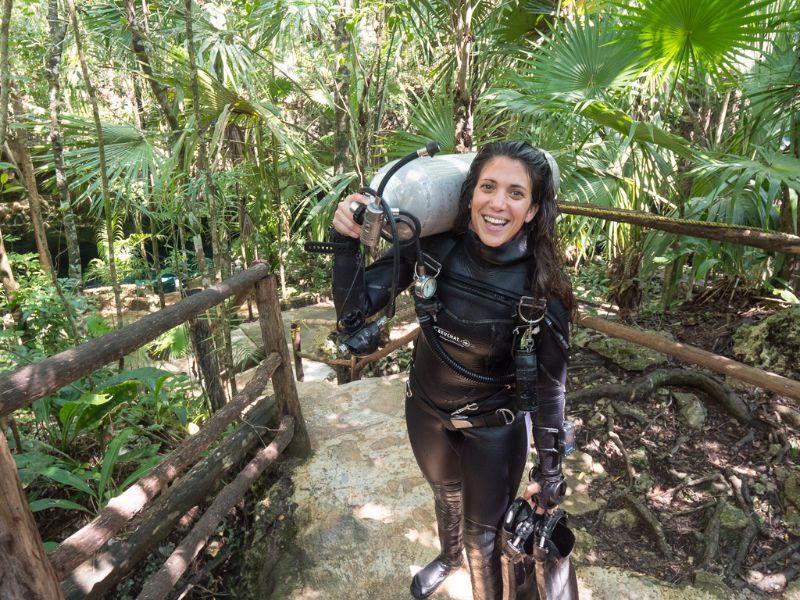
1. Why México is a Top Cave Diving Destination?
México stands as one of the world’s premier destinations for cave diving, thanks to its unique geography, abundant cenotes, and rich marine biodiversity. The country’s well-established tourist infrastructure supports this activity, offering specialized guides and dive centers that provide training and excursions.
What makes cave diving in México especially appealing are several key features:
Mexico offers some of the most thrilling cave diving experiences in the world, with various types of underwater caves waiting to be explored. Whether you’re into cenote diving or more adventurous underwater cave exploration in Mexico, there’s something for every level of diver. Let’s take a look at the different types of caves you can dive into and where to find the best cave diving spots in Mexico.
In short, cave diving in México is not only an exciting adventure but also a way to deeply connect with the country’s natural beauty and geology.
2. Types of Cave Diving in Mexico
- Solution Caves
Among the most well-known cave diving destinations in Mexico are the solution caves. These caves form over millennia, as water carves its way through the ground, creating vast underground systems. The deepest underwater caves in Mexico are found here, including the world’s largest underwater cave system, discovered in 2018 near Tulum. Stretching an impressive 215 miles (346 km), this cave system includes famous cenotes like Dos Ojos. Cenote diving in Mexico is a must-do for recreational divers, where you can enjoy guided cavern diving tours with experienced instructors.
For those seeking more advanced experiences, cave diving courses in Mexico are available, preparing you to explore the underwater labyrinth of these ancient systems. With proper cave diving equipment and cave diving safety protocols, divers can experience breathtaking underwater cave flora and fauna.
- Coral Caves
If you’re looking to combine cave diving with other activities in Mexico, coral caves are a fantastic option. These are formed by coral growth, creating tunnels and passageways that are perfect for cavern diving. The best cave diving spots for coral caves are on Cozumel Island, where you’ll find renowned locations such as Palancar Caves, Punta Sur, and Colombia Reef. These dive sites offer stunning swim-throughs and are ideal for certified divers who want to enjoy the vibrant life and clear waters of the Caribbean.
- Marine Caves
In addition to cenote diving, marine caves are another type of underwater cave exploration in Mexico. These caves are shaped by the powerful action of ocean waves, and they can be found along the coasts of the Sea of Cortez and Baja California. These destinations offer a unique mix of marine life and rugged underwater landscapes for adventurous divers.
- Lava Tubes
While the history of cave scuba diving in Mexico is rich with natural wonders, lava tubes are a rarer find here compared to places like Hawaii. However, intense volcanic activity in the Gulf of California has resulted in some formations, giving divers the chance to explore these fascinating structures.
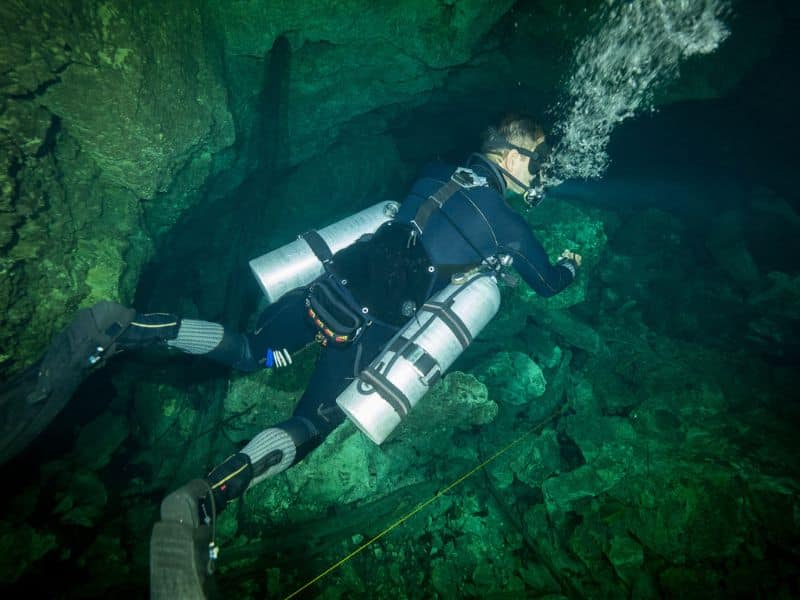
3. Cavern Diving vs. Cave Diving in Mexico
Cave Diving in Mexico is the best option for all of those scuba divers who are attracted to the bowels of the Earth. This thrilling form of underwater cave exploration in Mexico offers an experience unlike any other, revealing hidden wonders that few will ever witness. Whether you’re interested in cenote diving in Mexico or exploring the deepest underwater caves in Mexico, this activity can elevate your diving to new heights.
However, it’s important to understand what makes cave diving destinations in Mexico so unique and distinguish them from standard open-water dives. Cavern diving and cave diving are not the same thing, so let’s explore the difference.
While the terms “cavern” and “cave” may seem synonymous, they represent different experiences in the world of diving. In both cases, there’s a physical barrier between the diver and the surface, preventing direct ascent.
However, when cavern diving in Mexico, sunlight is always visible, and you’re within an emergency swimming distance from the cave entrance. This means you won’t descend beyond 70 feet (21 m) or stray more than 200 linear feet (60 m) from the entrance. Cavern diving is strictly a daytime activity, making it a safe and fun recreational option for divers with at least an Open Water Certification.
In contrast, cave diving in Mexico blends scuba diving with speleology. Cave divers must possess advanced skills in buoyancy control, cave diving safety, and the use of specialized equipment. These skills are typically acquired through certifications like Intro to Cave or Full Cave Diver courses, which are offered by professional cave diving agencies in Mexico such as Technical Diving International TDI, Global Underwater Explorers GUE, International Association of Nitrox and Technical Divers IANTD, among others.
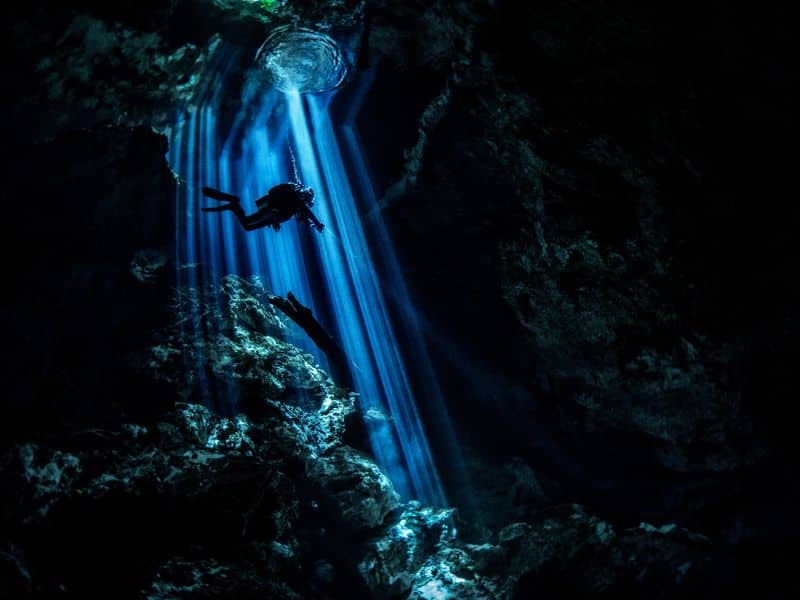
4. How to Become a Cave Diver?
Cave diving in Mexico offers an unparalleled adventure for those passionate about underwater exploration. However, it’s crucial to understand that cave diving in Mexico requires specialized training and equipment. According to expert Victor Córdoba, underwater cave exploration in Mexico has to be done correctly and demands rigorous preparation. Before embarking on this thrilling journey, divers need an advanced open water certification, at least 100 dives, and mastery in low-light communication and navigation in tight spaces.
The initial steps toward cave diving certification begin with cavern diving, a form of recreational diving that introduces overhead environments where direct ascent is impossible. Cavern diving still allows sunlight penetration, but as divers progress, they move into more challenging environments like cenote diving in Mexico, where advanced skills are necessary. In these caves, divers are restricted to consuming no more than 1/3 of their air tanks and must avoid certain passages, requiring mastery in cave diving navigation.
As divers advance, they learn technical skills such as deep diving and gas mixing, which are essential when exploring the deepest underwater caves in Mexico, where sunlight never reaches, and decompression stops are mandatory. The courses typically span 5-6 days, with trainees completing 16 to 24 dives by the end. These skills are vital, as cave diving safety in Mexico requires precision in buoyancy, finning, and navigation.
Cave diving courses also emphasize the importance of proper equipment. Cave diving equipment in Mexico goes beyond recreational diving gear; divers need thermal protection like dry suits due to the low temperatures in deep underwater caves. Life support systems must also be robust, with gas mixtures tailored for extended dives and deep descents. Essential tools like reels, markers, knives, and specialized flashlights are also part of the kit, ensuring redundancy in case of emergency.
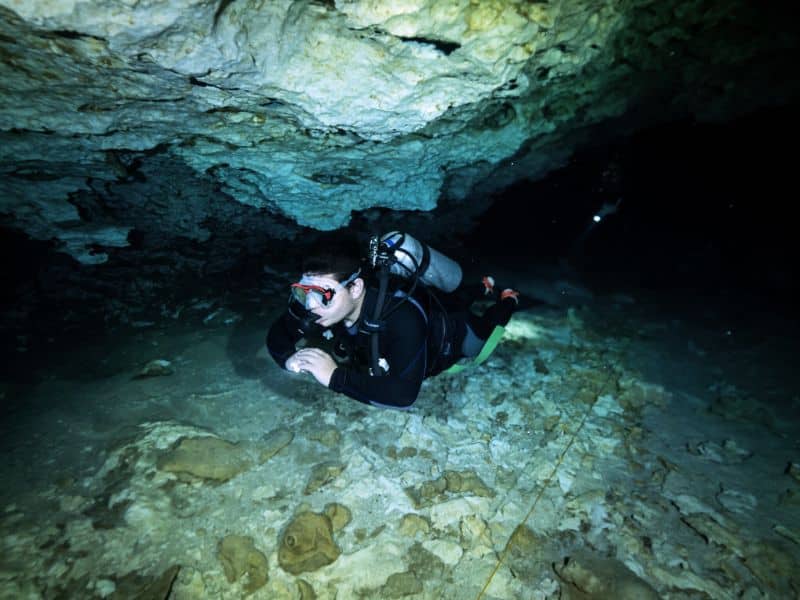
5. Best Destinations in Mexico for Cave Scuba Diving
Cave diving in Mexico offers some of the most thrilling and unique underwater experiences, with destinations like Cenote Dos Ojos, Cenote Angelita, and Cenote The Pit being among the top spots for underwater cave exploration. These locations attract divers from around the world, looking to explore the deepest underwater caves in Mexico, and experience both recreational and technical dives. Whether you’re diving in a cenote or navigating the complex passages of an underwater cave, Mexico’s dive sites offer something for everyone.
Top Cave Diving Spots in Mexico
- Cenote Dos Ojos: Known for its extensive cave system, this site is popular for both recreational and technical diving. With its intricate passages and breathtaking formations, it’s one of the best cave diving spots in Mexico. Advanced divers can enjoy the thrill of exploring deeper routes and unique geological structures.
- Cenote Angelita: Famous for its underwater river created by a layer of hydrogen sulfide, this cenote offers a visually stunning and challenging dive. Due to its depth and the need for precise buoyancy control, it’s a favorite among experienced divers. It also provides a unique perspective on underwater cave flora and fauna in Mexico.
- Cenote Chac Mool: Offering multiple passages and varying depths, Cenote Chac Mool is ideal for technical diving. Its crystal-clear waters and beautiful formations make it an excellent place for underwater cave exploration.
- Cenote Carwash (Cenote Aktun Ha): Known for its pristine waters and diverse aquatic life, this cenote offers both recreational and technical diving opportunities. Divers can challenge themselves in the deeper sections, honing skills acquired from cave diving courses in Mexico.
- Cenote The Pit: Located near Tulum, this deep cenote is a visually captivating dive, thanks to the stunning light effects created by sunlight filtering through the water. It’s one of the deepest underwater caves in Mexico, perfect for advanced technical divers.
- Cenote Taj Mahal: Offering a more serene diving experience, Cenote Taj Mahal is less crowded and ideal for technical divers looking to explore quieter, intricate cave systems.
These locations also offer opportunities to combine cave diving with other activities in Mexico, such as exploring ancient ruins or enjoying the vibrant marine reef life.
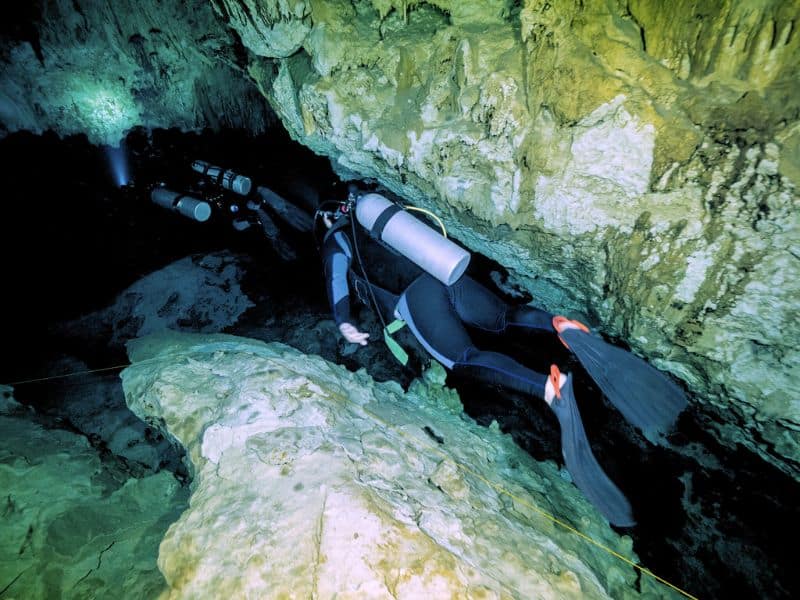
6. Planning Your Cave Scuba Vacation in Mexico
Whether you’re new to cave diving or a seasoned pro, cave diving vacations in Mexico offer an unparalleled mix of beauty and adventure.
Dressel Divers provides cavern diving courses, equipment, and guides, ensuring you have a safe and unforgettable experience.
For us, safety is paramount, and divers are encouraged to take cave diving courses and familiarize themselves with the proper cave diving equipment before attempting the more advanced dives. Cave diving safety in Mexico is taken seriously, with strict guidelines and protocols in place to ensure every diver has the best experience possible.
The rich history of cave diving in Mexico continues to attract adventure seekers from all over the world, and with so many incredible cave diving destinations to choose from, your next dive in Mexico will surely be one to remember.
Would you like to practice cave diving with us? Drop us a line!
CONTACT US FOR
PERSONALIZED ASSISTANCE
Send your inquiries
We have you covered
GET 20% OFF
Exclusive discounts just for online bookings




